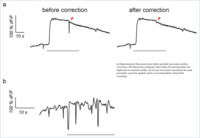A microfluidics-based method for measuring neuronal activity in Drosophila chemosensory neurons
- Giesen, Lena van Department of Biology, Institute of Zoology, University of Fribourg, Switzerland - Department of Biology, Brandeis University, Waltham, Massachusetts, USA
- Neagu-Maier, G. Larisa Department of Biology, Institute of Zoology, University of Fribourg, Switzerland
- Kwon, Jae Young Department of Biological Sciences, Sungkyunkwan University, Suwon, Republic of Korea
- Sprecher, Simon G. Department of Biology, Institute of Zoology, University of Fribourg, Switzerland
-
03.11.2016
Published in:
- Nature Protocols. - 2016, vol. 11, no. 12, p. 2389–2400
English
Monitoring neuronal responses to defined sensory stimuli is a powerful and widely used approach for understanding sensory coding in the nervous system. However, providing precise, stereotypic and reproducible cues while concomitantly recording neuronal activity remains technically challenging. Here we describe the fabrication and use of a microfluidics system that allows precise temporally restricted stimulation of Drosophila chemosensory neurons with an array of different chemical cues. The system can easily be combined with genetically encoded calcium sensors, and it can measure neuronal activity at single-cell resolution in larval sense organs and in the proboscis or leg of the adult fly. We describe the design of the master mold, the production of the microfluidic chip and live imaging using the calcium sensor GCaMP, expressed in distinct types of Drosophila chemosensory neurons. Fabrication of the master mold and microfluidic chips requires basic skills in photolithography and takes ~2 weeks; the same devices can be used repeatedly over several months. Flies can be prepared for measurements in minutes and imaged for up to 1 h.
- Faculty
- Faculté des sciences et de médecine
- Department
- Département de Biologie
- Language
-
- English
- Classification
- Biological sciences
- License
-
License undefined
- Identifiers
-
- RERO DOC 277729
- DOI 10.1038/nprot.2016.144
- Persistent URL
- https://folia.unifr.ch/unifr/documents/305137
Other files
Statistics
Document views: 89
File downloads:
- Supplementary material: 181
- pdf: 274

